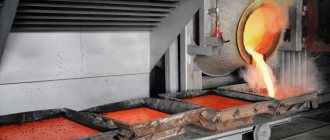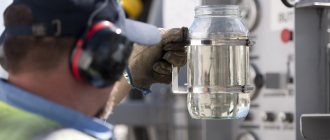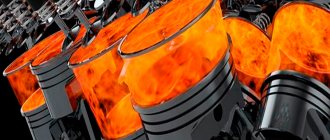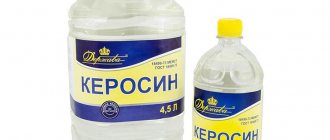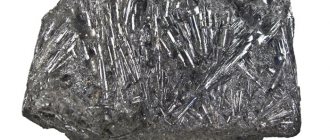06.04.2018
The density of kerosene is one of many characteristics of a substance that determine its properties. Before the advent of specialized equipment, it was this parameter that demonstrated the quality of the material. Kerosene is used in various industries and is suitable for many processes, so it is necessary to accurately know the density and other indicators of this substance, their changes and boundary marks.
The density of kerosene depends on the manufacturing methods and temperature changes
What is kerosene
Being in the aggregate state of liquid, it is a mixture of various hydrocarbons. The main raw material for the production of kerosene remains oil, as the main source of various combustible and lubricating fractions. On a modern industrial scale, fuel is obtained by classical distillation or rectification. The main use of kerosene is determined by its physical and chemical properties. The boiling point is in the range from 150 to 250 degrees, more resistant to detonation, safe for use at high altitudes. The range of applications is quite wide: it is used in lighting fixtures, garden equipment, diesel power plants, aircraft engines and rockets.
Kerosene appears to be a clear, oily liquid. It may have a yellowish tint, which depends on the method of production (area of application).
Who discovered kerosene
The invention of this hydrocarbon liquid is attributed to the ancient scientist from Persia - Razi Muhammad. The discovery of kerosene occurred as a result of simple distillation, when one of its fractions was actually evaporated from crude oil. Taking into account the development of exact sciences at that time, it was not possible to accurately determine the composition of kerosene. For this reason, the liquid was used until the 19th century for its elementary property - flammability as part of lighting architectural elements.
The use of kerosene as a patented substance dates back to 1854. During this period, the era of inventions began, so Abraham Gesner hastened to secure a patent for the light oily substance.
Why is this liquid called kerosene?
Kerosene owes its name to the ancient Greeks. The translation of the word Keros sounds like wax. This is exactly how the distant ancestors of humanity perceived that substance. A fairly simple method of production made it possible to accumulate impressive reserves of oily liquid. The fuel oil produced in parallel, however, has not found such wide application as kerosene in terms of combustion temperature in lamps or simple heaters. Often, excess “ancient wax” was burned directly in storage. This happened until the chemical structure of the substance was thoroughly studied.
Specific heat capacity of kerosene at different temperatures
The table shows the specific heat capacity of kerosene at various temperatures. The heat capacity of kerosene is indicated in the temperature range from 20...270°C. The value of the specific (mass) heat capacity of kerosene is determined by its composition, that is, the content of aromatic and paraffin hydrocarbons. The less paraffins and olefins there are in kerosene, the lower its heat capacity.
The specific heat capacity of kerosene depends on temperature - it increases when the fuel is heated. The dependence of heat capacity on temperature is nonlinear. At room temperature, its specific heat capacity is 2000 J/(kg K). At high temperatures, the value of this thermophysical property of kerosene can reach 3300 J/(kg K).
In addition, the heat capacity of kerosene also depends on pressure.
As pressure increases, it decreases; at high temperatures, the effect of pressure increases. It should be noted that the dependence of the heat capacity of kerosene on pressure is not linear. Specific heat capacity of kerosene - table
| t, °С | Cp, J/(kg K) | t, °С | Cp, J/(kg K) | t, °С | Cp, J/(kg K) |
| 20 | 2000 | 110 | 2430 | 200 | 2890 |
| 30 | 2040 | 120 | 2480 | 210 | 2940 |
| 40 | 2090 | 130 | 2530 | 220 | 3000 |
| 50 | 2140 | 140 | 2580 | 230 | 3050 |
| 60 | 2180 | 150 | 2630 | 240 | 3110 |
| 70 | 2230 | 160 | 2680 | 250 | 3160 |
| 80 | 2280 | 170 | 2730 | 260 | 3210 |
| 90 | 2330 | 180 | 2790 | 265 | 3235 |
| 100 | 2380 | 190 | 2840 | 270 | 3260 |
Kerosene composition
Given the possibility of being obtained by distillation, this liquid occurs in nature in its pure form. In a simple structure, it is a mixture of hydrocarbons in varying percentages. The volume of components depends on the oil field.
Liquid composition:
- Hydrocarbons: Aliphatic. In a volume from 20 to 60 percent;
- Aromatic – up to 25%;
- Naphthenic – up to 50%.
- Nitrogenous;
Depending on the percentage of one or another component, kerosene’s chemical composition may show the predominance of certain qualities. That is why, when used responsibly, laboratory tests are carried out and the quality of the raw materials is taken into account. In modern conditions, in order to obtain a liquid with a precise component composition, the fuel manufacturing technology is modified.
Method for producing kerosene
Currently, the liquid used as fuel is produced from petroleum. On a small scale, the traditional distillation method is used. When heating raw materials in special cubes, hydrocarbon compounds begin to actively separate from the fuel oil base. The method is based on the physical properties of kerosene, when lighter fractions are separated from heavier ones when heated. The method is not secret, so it can be easily reproduced at home.
With the growing need for advanced fuels and the imposition of quality requirements, industrial methods for producing a mixture of hydrocarbon compounds are emerging. So, starting in 1866, the cracking (or splitting) method appeared. In fact, the promising American used a slightly modified pressure distillation. True cracking, which laid the foundation for the production of kerosene grades, appeared in 1981 thanks to the Russian engineer Gavrilov. From this moment, the industrial production of fuel begins its countdown, in which the depth of processing has significantly increased (the volume of waste has decreased).
What is kerosene used for?
Today this type of fuel is used for its intended purpose. Application directly depends on the brand, variety, and area of demand. When purchasing for industrial needs, the mixture’s compliance with current standards for consistency, density, hydrocarbon composition and other physical and chemical properties is checked.
In addition to technical purposes, certain brands of kerosene are known to be used for medical purposes. The liquid is used to remove lice, as a basis for lotions and ointments for the treatment of skin diseases. With a certain component composition, it is used as part of drugs for the treatment of diseases of the lungs, nervous system or gastrointestinal tract.
Story
Information about the distillation of oil begins in the 10th century AD. However, distillation products were not widely used despite information about the use of oil in oil lamps. The industrial use of light petroleum products in lighting began in the 40-50s of the 19th century. Various people have demonstrated the production of a light, low-odor flammable liquid by distillation from coal, bitumen, and oil. A number of patents were obtained. In 1851, the first industrial distillation plant in England came into operation. In 1854 the trademark “kerosene” was registered. The process of adapting oil lamps into a kerosene lamp began. In 1853, in Lviv, workers at the pharmacy of Peter Mikolyash “Under the Golden Star”, Ignatiy Lukasiewicz and Jan Zeg developed a method for distilling and purifying oil. Now it was possible to begin the production of kerosene, or “new campine”, as Lukashevich called kerosene. In December 1853, scientists received an Austrian patent. In the same year, Zeg opened the first small oil refinery in Lviv. In the 19th century, only kerosene was used from oil distillation products (for lighting), and the resulting gasoline and other petroleum products had extremely limited use. For example, gasoline was used for pharmaceutical and veterinary purposes, as well as as a household solvent, and therefore oil industrialists simply burned large reserves of it in pits or poured them into reservoirs. In 1911, kerosene lost its leading position to gasoline in the world petroleum products market due to the spread of internal combustion engines and electric lighting. The importance of kerosene began to increase again only in the 1950s, due to the development of jet and turboprop aviation, for which this particular type of petroleum product (jet fuel) turned out to be an almost ideal fuel. The origin of the word kerosene is also interesting. Thus, in the Russian Encyclopedia (vol. 10, p. 42), published in St. Petersburg by the book partnership “Activist”, it is said: “Kerosene... was put on sale by the trading house “Care and Son”, hence the name.” . However, in the Great Soviet Encyclopedia we read: “Kerosene (English kerosene, from the Greek kerós - wax)”
Main types of kerosene
A flammable viscous liquid obtained from petroleum, classified by application. There are technical, lighting, missile and aviation types of factions. If they say that kerosene is a fuel for cars, this is not entirely true. Diesel is used to refuel cars.
Technical
One of the most popular types of substance. It is known to use kerosene according to its chemical formula as a raw material for the production of certain groups of hydrocarbons. These are propylenes, ethylenes and more complex chains, on the basis of which solvents, plastics, plasticizers, and powder compositions for waterproofing are produced. Kerosene is often used as technical fuel for heating industrial premises, workshops, and workshops. The main difference from other varieties remains the content of aromatic hydrocarbons. Their volume should not exceed 7 percent of the total mass.
Missile
As the main combustible fuel, kerosene, almost in its pure form, is used to launch space and military vehicles. The specific heat of combustion parameters provide effective thrust sufficient to impart impressive kinetic force to various objects. At the same time, the sufficiently high ignition temperature of kerosene creates safe conditions in critical piloting conditions.
Aviation
Civil, military and special types of communications on manned aircraft operate on this type of fuel. Various brands of jet fuel are used for refueling and as a technical fluid. Known to be highly resistant to ignition from accidental electrical discharges. If conditions are met, it can be stored as emergency reserves (defense industry, remote sites).
Lighting
Due to the unique physical properties of kerosene during combustion (at temperatures ranging from 35 to 75 degrees), a minimal amount of by-products is released. High-quality raw materials are especially valued, providing an effective and long-lasting glow.
Types, types and brands of kerosene:
The following types of kerosene are distinguished: aviation kerosene (jet fuel), rocket kerosene, technical kerosene and lighting kerosene.
Aviation kerosene is a motor fuel for turboprop and turbojet engines of various aircraft, and is also used as a coolant in various heat exchangers (fuel-air radiators), as a lubricant for moving parts of fuel and engine systems, and as a solvent.
In Russia, five grades of aviation kerosene are produced for subsonic aviation (TS-1, T-1, T-1S, T-2 and RT), and two for supersonic aviation (T-6 and T-8B). RT brand aviation kerosene is a standardized fuel and is intended for use on aircraft with both subsonic and supersonic flight speeds.
Rocket kerosene is a jet fuel used in air-breathing rocket engines. It is also the working fluid of the engine mechanism.
Technical kerosene is used as a raw material for the pyrolytic production of ethylene, propylene and aromatic hydrocarbons, as a fuel mainly for firing glass and porcelain products, and as a solvent for washing mechanisms and parts.
Two grades of technical kerosene are produced: KT-1 and KT-2.
Lighting kerosene is a special type of kerosene intended for refilling lamps and heating devices. It is also used for degreasing rolled metal and spare parts, washing mechanisms and parts.
Four grades of lighting kerosene are produced in Russia: KO-20, KO-22, KO-25, KO-30.
Main indicators of the physical properties of kerosene
Suppliers of fuel for various needs are leading petrochemical companies. Often the supply is carried out by private industries working in the direction of unique developments. When forming industrial reserves, a number of characteristics and properties of kerosene are taken into account. Physical parameters are most often studied in combination with chemical formulas. In this regard, the following mixed properties are distinguished:
- Density;
- Viscosity;
- Heat released during combustion;
- Flash points, boiling points;
- Liquid color. It happens without color, yellowish or light brown tint;
- Chemical composition. Depends on the raw materials;
- Concentration limit of ignition. By analogy with natural gas, the volume of a substance in nearby air mixed with kerosene vapor is studied;
- Acidity
Kerosene density
This physical quantity directly depends on the temperature of the liquid. To compile a density table, measurements are taken at various degrees of heating of the sample taken for research. An increase in the parameter is achieved through the use of various production technologies and increasing the content of heavy hydrocarbons. When heated, a direct dependence of density is observed; it begins to decrease. For example, at a temperature of 20 degrees, the density is at the level of 819 kg/m3, then rushes to a value of 618 kg/m3 when heated to 270 degrees. This property should be taken into account in practical applications. The initial density of the substance is less than water, which is why almost all oil derivatives form a continuous film on the surface of reservoirs.
Approximate properties depending on where kerosene is used:
- Aviation brands TS-1 -780 kg/m3, TS-2 – 766 kg/m3;
- Lighting – 840 kg/m3.
Kinematic viscosity of kerosene
In practice, this indicator is obtained by calculation. The initial data for calculations are density and dynamic viscosity. The parameter is used to determine the lubricating properties of a substance when used as a technical fluid in industry and aviation. The kinematic viscosity indicator is taken into account when filling storage tanks, tanks, reservoirs and other types of containers.
The parameter remains directly dependent on the degree of heating, the initial value is taken as 1.819·10-6 m2/s, maintained at a temperature of 20 degrees. Kinematic viscosity decreases less actively than dynamic viscosity (in a ratio of 4.8 versus 5.7).
Flash point of kerosene
This parameter is often studied as the flammability of a liquid. By definition, this is the starting temperature at which vapors above the tank (container, pipeline) ignite. However, the flash level does not indicate detonation of the entire volume of kerosene used. The initial parameter used for industrial supply purposes is 28 degrees. If there is a downward deviation from this parameter, fuel is not allowed for sale. In practice, active ignition of kerosene occurs when heated (for example, with compressed air) to 300 degrees. In this case, the flash point takes into account unauthorized fire (from extraneous sources).
Heat from burning kerosene
The starting value is 43 MJ per kg of fuel. The parameter is taken into account when burning raw materials for space heating. The level of influence on adjacent mechanisms during active combustion of fuel in jet engines is also being studied.
Specific Gravity Calculations
In order to carry out the necessary calculations, it is necessary, first, to decide what this concept means.
Specific gravity is a designation for the ratio of the weight of a required substance to its volume. This parameter is calculated using the formula: y=p*g, where y is specific gravity, p is density, g is gravitational acceleration, which in normal cases is a constant and equals 9.81 m/s*s.
Results are measured in Newtons divided by cubic meter (N/m3). To convert to the international system, that is, in kg/m3, we multiply the value by 0.102.
Is kerosene dangerous for humans?
As with any technical fluids, it all depends on the quantity. Considering the fact that kerosene is obtained from oil as a natural resource, it is harmless in small quantities. The substance is often used for medical purposes, but mostly for external use. If they enter the esophagus, heavy fractions can cause deterioration of health and allergic reactions. In such cases, decontamination elements should be adopted.
Speaking about what kerosene is, we should remember about an extremely interesting set of chemical elements and active compounds to study. Practical properties as a fuel, technical fluid, and feedstock for various types of industry keep this substance at the level of global consumer demand.
The emergence of kerosene in Russia
Various types of fats and illuminating gas used in Russia for lighting were completely replaced by kerosene in the 19th century. The density of kerosene and its combustible properties were much superior to their properties. The massive use of kerosene led to an increase in oil demand, which led to increased volumes and more advanced production of malta.
The invention of the kerosene lamp in 1853, which replaced the oil lamp and indirectly led to the development of an active kerosene industry.
The beginning of the twentieth century was marked by attempts to use kerosene to fuel agricultural machinery. But due to the low volatility and low octane number of this petroleum product, starting a cold engine was quite difficult. The consumption of kerosene was enormous; it was necessary to install an additional gas tank in the equipment. Therefore, diesel fuel and gasoline soon completely replaced it.
In the middle of the twentieth century, the aviation and rocket industry began to flourish, where kerosene became an indispensable fuel.
